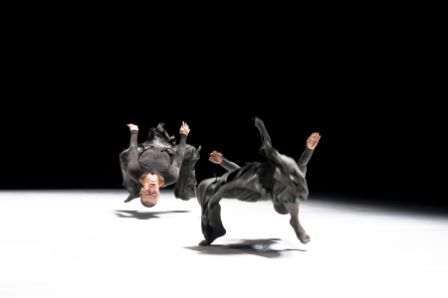From my Financial Times review of the Tao Dance Theatre, at Lincoln Center Festival last week–one of the few modern dance companies from mainland China, and extraordinary:
China came late to modern dance – and nothing is as deadly as a recent convert’s earnest faith. So when the programme declared that Beijing choreographer Ye Tao, of the five-year-old Tao Dance Theater, “eschews representational modes of dance” even to the point of forgoing words for numerals in dance titles, I thought I knew the kind of discovery we were in for: all on their end, none on ours. What a relief to be wrong.
The 90-minute show was not easy. The impersonality of its outrageousness may have precluded hot-headed protest, but by the halfway mark of the second piece the entire row behind me had tiptoed out.
This duet, entitled 2, began with Tao and co-choreographer Ni Duan lying on their bellies for five minutes like green mould against the bright white floor while folk-punk composer He Xiao engulfed us in high-pitched static. The piece ended strangely too, with the eccentric music carrying on after the dance had finished and the dancers had re-entered to wait for it to croak its last so they could bow.
It was the first time they stood. Until then the duo had flopped about on their bellies and backs and sidled samurai-style from knee to knee in swampy, swirly, unexpectedly gorgeous patterns. But more than the low-riding style, the long freezes or the industrial detritus that Xiao mixed with fairy tinkles and swathes of chalky cello, it was 2‘s flouting of structure that proved bracing – or, for some, unbearable. The duet was all about starting and stopping and starting again without ever quite becoming.
Ye Tao and Ni Duan riding low in 2. Photo by Matthew G. Johnson courtesy of the Lincoln Center Festival.
I admired the squirm-inducing 2, but 4 really made me want to keep up with the young choreographer’s work.
For what distinguished 4 from 2, please click. Every click is a click for dance (and you only have to free-register once for perpetuity).


Thank you for such honest, engaged review and congratulation for escaping the trapping of seeing their work as simply a form of “otherness”. Tao Dance Theatre has been so misread by NY critics. Last year, a NYT critic calls their piece as something of Keersmaeker’s Fase translation in Chinese robe! (simply because they use the similar Cage’s music). So it’s such a relief to read yours!
Dear Helly,
Thank you for reading my review, and I’m very pleased you found it an accurate reflection of Ye Tao’s work. I didn’t find the reference to de Keersmaeker’s “Fase” in my colleague’s review last fall in any way a belittlement of Tao Dance Theatre’s achievement, but simply a useful–and, I think, accurate–comparison, meant to help those readers who are more familiar with de Keersmaeker’s early work (which was at BAM a few years ago) than with the young Tao Dance. To say that two things are alike doesn’t mean that one is derivative of the other.
Thank you very much for writing,
Apollinaire